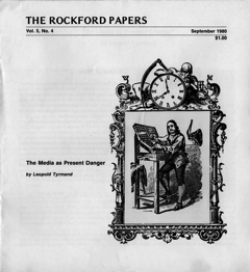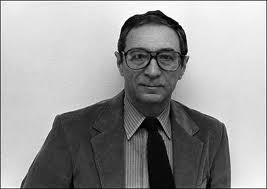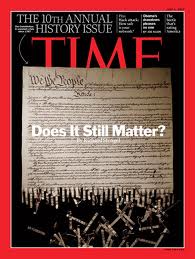
First Amendment Follies
 A recent study of media bias conducted by Tim Groseclose and Jeffrey Milyo*, reminded this writer of a 1980 article by Leopold Tyrmand** in The Rockford Papers, a periodical published by the Rockford Institute. The magazine is long gone. There is not even a mention of it on the Institute’s web site. However, a few treasured copies remain on the family bookshelves. Tyrmand’s “The Media as Present Danger,†is one.
A recent study of media bias conducted by Tim Groseclose and Jeffrey Milyo*, reminded this writer of a 1980 article by Leopold Tyrmand** in The Rockford Papers, a periodical published by the Rockford Institute. The magazine is long gone. There is not even a mention of it on the Institute’s web site. However, a few treasured copies remain on the family bookshelves. Tyrmand’s “The Media as Present Danger,†is one.
Tyrmand makes three assertions:
- “the American communication media are authoritarian ingredients in a democratic society;â€
- “they affect our foreign policy in a fashion which throws doubt on their loyalty;â€
- “they create a sociocultural climate which is detrimental to democratic civilization.â€
Tyrmand’s assertions resonated then, and with the passage of time, their truth has become more evident. This writer will concentrate on assertions one and three.
He accuses the media of pretending to report objectively while it “shapes and engineers public opinion, social climates, cultural and behavioral trends and fashions in keeping with the liberal tenet.â€
He writes that as a nation we are products of the Judeo-Christian civilization—“the sum of ideas and experiences of societies that have derived their beliefs, morality and symbols from a unified cultural tradition.â€Â A tradition, he sees the media ruthlessly, carelessly and often deliberately eroding.
In 1993, Senator Patrick Moynihan coined the phrase “defining deviancy down,” to describe a new public tolerance for intolerable or destructive behavior.
 Tyrmand’s explains why the media influence is so powerful. “It is the journalists’ access to the process of unrestricted, endless repetition of what he wants to say—in print, on the air, on the screen.†In this way, Tyrand writes, the media does not just report American reality, they create it. Reality is what the media says it is.
Tyrmand’s explains why the media influence is so powerful. “It is the journalists’ access to the process of unrestricted, endless repetition of what he wants to say—in print, on the air, on the screen.†In this way, Tyrand writes, the media does not just report American reality, they create it. Reality is what the media says it is.
In the media lexicon every behavior, no matter how damaging to the participants or the culture is merely a ‘lifestyle.’ The old taboos against irresponsible behavior are gone. Martin Luther King’s admonition that people should be judged by the content of their character, not the color of their skin has given way to the diversity imperative now part of the liberal worldview and endorsed by the media.
With the entrance of the media, the new conditioner of man’s psychology, into the field of creating reality, evil—which may have been alluring or seductive when portrayed by literary giants—becomes just attractive. And this meant a whole new ball game.
Tyrmand writes that temptation,
which may be induced by reading about Othello’s impassioned violence, still requires some moral choice, attractiveness eliminates the need for moral choices …Â
Rather than being condemned by moral commentary –“which the media hate as the devil hates holy water,†they are protected by their invincible shield, the First Amendment. They are in charge of not only what gets printed, but also how it is presented.  Tyrmand writes,
By aggregating information, interpretation and entertainment under one command, the media create cultural climates that alter human character and behavior with results hitherto unknown.
Groseclose and Milyo’s study, published in the November 2005 Quarterly Journal of Economics, reveals one set of results.
Charlotte Allen in the August 15th issue of The Weekly Standard, writes, “The study, using rigorous quantitative analysis, found that most major American news outlets, including newspapers such as the New York Times and the Washington Post, news weeklies such as Time and Newsweek, network television shows such as a CBS Evening News and NBC Nightly News, and Internet sites such the Drudge Report, slanted their news reporting to reflect a distinct liberal bias.“ The authors found that nearly all reporters “pull the Democratic lever in the voting booth†and despite protestations to the contrary, their political orientation colors what they report, the way they report, and what they do not report.
How Groseclose and Milyo measured media bias, is a bit of delicious irony.  They used an adjusted version of the scores that  “the famously liberal†Americans for Democratic Action use to “rate members of Congress according to their roll call votes on hot button issues.†Groseclose and Milyo also measured how often reporters cited leftist think tanks and advocacy groups compared to citations from their opposite numbers.
Groseclose has written a book about the study, Left Turn, How the Media Bias Distorts the American Mind,†intended for general readers. Weekly Standard writer Allen highly recommends the book, noting that the author has a gift for making technical terms understandable and for writing with clarity and humor.
 In Left Turn Groseclose cites numerous examples of biased and misleading reporting.  But astute readers and observers don’t need the examples. All they need do is open their morning papers or an issue of Time or Newsweek. Recent efforts to trash Sarah Palin, Michelle Bachmann, and the Tea Party, not to mention the Constitution, are commonplace.
In Left Turn Groseclose cites numerous examples of biased and misleading reporting.  But astute readers and observers don’t need the examples. All they need do is open their morning papers or an issue of Time or Newsweek. Recent efforts to trash Sarah Palin, Michelle Bachmann, and the Tea Party, not to mention the Constitution, are commonplace.
This week’s Arizona Republic carried a Washington Post story headlined “No diversity seen in debt ‘supercommittee.’â€Â The lead paragraph states that panel members represent “a broad range of ideological views,†but that apparently is not sufficient. The next paragraph identifies the “lack of gender and racial diversity†as a â€problem.†As if the panel tasked to seek solutions to the nation’s soaring debt must include lobbyists for gender and ethnic interest groups to be legitimate.
Not quite as obvious, if people aren’t paying attention, is media reluctance to report stories that are unflattering to the liberal political establishment. Think Move On, Planned Parenthood, and New Black Panthers’ intimidation of voters. These stories were only reported after conservative outlets made them impossible to ignore. Instead, we are inundated with daily reports of Casey Anthony’s trial, the latest escapades of Lindsay Lohan or the alcoholic/drug-addled ravings of Martin Charlie Sheen. Or contrast media efforts to shield a president who is either incompetent or ideologically blind to the disastrous results of his party’s policies, or both, with media treatment of President George W. Bush.
In addition to validating that media liberal bias actually exists and is not a manifestation of right-wing paranoia, the book includes the thesis that media liberal bias is so pervasive that it distorts Americans’ political views.
Tyrmand did not live long enough to see talk-radio and the Internet become the sources of dissident voices they are now. The dissident minority cannot change liberal media bias, but it can provide a counterpoint for anyone willing to listen to the music.
*Groseclose is a professor of political science and economics at UCLA; Jeffrey Milyo holds an endowed chair in social sciences at the University of Missouri.
**Leopold Tyrmand 1920-1985 was a Polish novelist and editor, resistance fighter during WW II, and concentration camp prisoner. He wrote for anti-regime Polish papers before coming to the United States. After coming to the US in 1966 he  published essays in The New Yorker, Commentary, and the American Scholar and became editor and co-founder of the Rockford Institute.
 The posts are coming!
The posts are coming!


2 comments
hello
alcoholic/drug-addled ravings of Martin Sheen. <—– Charlie Sheen not his Dad unless you know something we all don't.
[Reply]
Martin Reply:
August 29th, 2011 at 2:55 pm
Thanks! Corrected.
[Reply]
Leave a Comment